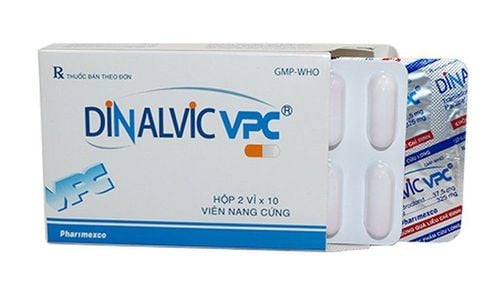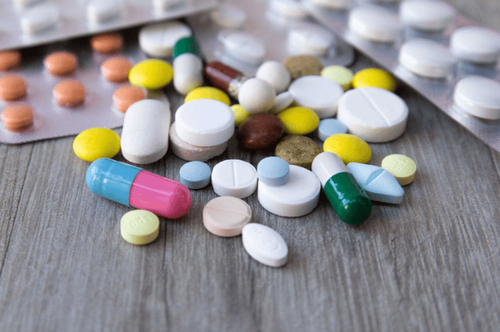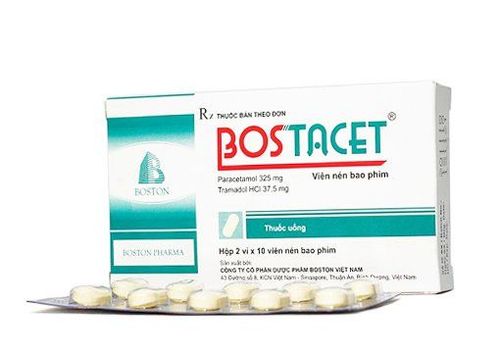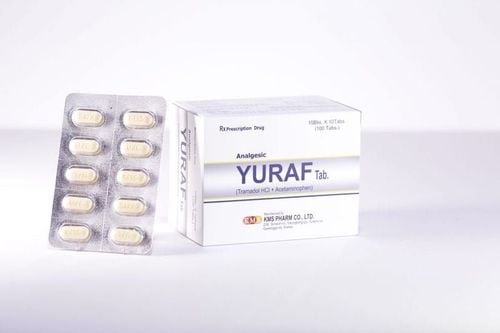This is an automatically translated article.
Poltrapa 325mg is a medication commonly used for the symptomatic treatment of moderate to severe pain. To better understand what is the use of Poltrapa? What are the side effects of Poltrapa? What is the correct way to drink? What should be noted when using? The following article will help you better understand the drug Poltrapa 325mg.1. What is Poltrapa 325mg?
Poltrapa from Polfarmex S.A. Company. The main ingredients are tramadol and paracetamol. Poltrapa is a medication for the symptomatic treatment of moderate to severe pain.
1.1. Dosage form In the form of film coated tablets
1.2. Active ingredients in 1 film-coated tablet:
Paracetamol (acetaminophen) 325mg Tramadol hydrochloride 37.5mg Excipients just enough. 1.3. Pharmacodynamics Tramadol is an opioid analgesic that acts on the central nervous system. Tramadol is a pure non-selective agonist for the μ, δ, ҡ opioid receptors and has a higher affinity for the μ receptor. Other mechanisms contributing to tramadol's analgesic effects are inhibition of noradrenaline reuptake and enhanced serotonin release.
Tramadol has the effect of reducing cough. Unlike morphine, the analgesic dose range of tramadol does not cause respiratory depression. Similarly, tramadol did not alter gastrointestinal motility. Effects on the cardiovascular system are generally very mild. The potency of tramadol is 1/10 to 1/6 of that of morphine.
The exact mechanism of the analgesic effect of paracetamol is unknown, possibly related to effects on the central and peripheral nervous system.
Poltrapa is classified as a class II pain reliever according to the World Health Organization's scale of indications for pain and must be taken by prescription.
1.4. Pharmacokinetics Absorption
Tramadol in the racemic form is rapidly and almost completely absorbed following oral administration. The mean absolute bioavailability of a single 100 mg dose is approximately 75%. After repeated dosing, bioavailability increases and reaches almost 90%. Following oral administration of Poltrapa, paracetamol is rapidly and almost completely absorbed and occurs mainly in the small intestine.
Peak plasma concentrations of paracetamol are reached in 1 hour and are not affected by co-administration with tramadol. Food does not affect the extent and rate of absorption of tramadol or paracetamol. So Poltrapa can be taken at any time of the meal.
Distribution
Tramadol has a high tissue affinity (Example: β = 203 ± 40 I). The rate of binding to plasma proteins is about 20%. Paracetamol is widely distributed in most body tissues except adipose tissue. The apparent volume of distribution is about 0.9 l/kg. A small percentage of paracetamol (about 20%) is bound to plasma proteins.
Metabolism
Tramadol is extensively metabolised after oral administration. About 30% of the drug is excreted in the urine as unchanged drug, while about 60% of the drug is eliminated as metabolites.
Tramadol is metabolised via O-methyl reduction (catalyzed by the CYP2D6 enzyme) to the M1 metabolite, via N-methylation (catalysed by the CYP3A enzyme) to the M2 metabolite. M1 is further metabolized via N-demethylation and conjugation with glucuronic acid.
The plasma half-life of M1 is 7 hours. M1 metabolite has a stronger analgesic effect than the parent drug. The plasma concentrations of M1 are several times lower than those of tramadol and contribute to a nearly constant clinical effect with multiple dosing. Paracetamol is metabolized mainly in the liver by two main pathways: glucuronication and sulphation. The sulphate pathway is rapidly saturated at higher than therapeutic doses. A small fraction (less than 4%) is metabolized by cytochrome P450 to the active intermediate (N-acetyl benzoquinonimin). Under normal conditions of use, this metabolite is rapidly eliminated by reduced glutathione and excreted in the urine after conjugation with cysteine and mercapturic acid. However, when large amounts of the drug are overdosed, the amount of this metabolite is increased.
Elimination
Tramadol and its metabolites are eliminated mainly by the kidneys. The half-life of paracetamol is approximately 2 to 3 hours in adults, shorter in children and slightly longer in cirrhotic patients and neonates. Paracetamol is also eliminated from the body mainly by conjugation with glucuronic and sulfate depending on the oral dose. Less than 9% of a paracetamol dose is excreted unchanged in the urine. The half-lives of both active substances were also prolonged in patients with renal impairment.
2. What are the uses of Poltrapa 325mg?
Poltrapa is a combination pain reliever of tramadol and paracetamol indicated for the treatment of moderate to severe pain symptoms. Use should be limited to patients with moderate to severe pain requiring a combination of tramadol and paracetamol.Some other effects of the drug that are not listed on the approved drug label, but your doctor may prescribe you to take. This drug is for a doctor's prescription.
3. Poltrapa 325mg . side effects
The combination of paracetamol and tramadol can cause some side effects such as:
Psychiatric disorders: confusion, mood swings, sleep disturbances (common), depression, hallucinations, nightmares , dementia (uncommon), drug dependence (rare). Nervous system disorders: dizziness, somnolence (very common), headache, tremor (common), muscle spasms, paresthesias, tinnitus (uncommon), ataxia, seizures (rare) Common) Eye disorders: blurred vision (rare) Cardiovascular disorders: hypertension, palpitations, tachycardia, arrhythmia (uncommon). Respiratory, thoracic and mediastinal disorders: dyspnea (uncommon). Gastrointestinal disorders: nausea (very common), vomiting, constipation, dry mouth, flatulence, dyspepsia, diarrhea (common), dysphagia, black stools (uncommon). Systemic and site-of-administration disorders: tremor, hot flushes, chest pain (uncommon) Renal and urinary disorders: albuminuria, urinary disturbances, dysuria, urinary retention (uncommon) Disorders skin and subcutaneous tissue: sweating, pruritus (common), rash, urticaria (uncommon) In addition, the occurrence of side effects known to be associated with take tramadol or paracetamol.
Tramadol may cause undesirable effects:
Orthostatic hypotension, bradycardia, heart failure Allergic reactions with respiratory symptoms (difficulty breathing, bronchospasm, wheezing, edema). neural circuits) and anaphylaxis. Changes in appetite, motor weakness, and respiratory depression Mood changes, changes in daily activities, or changes in cognitive and sensory abilities Withdrawal symptoms are similar to those of withdrawal. opioid medications such as agitation, anxiety, stress, insomnia, hyperactivity, tremors, and digestive problems. In addition, if tramadol is stopped abruptly, patients may experience panic attacks, severe anxiety, hallucinations, paresthesias, tinnitus, and central nervous system abnormalities.
4. Drug interactions
Concomitant use with:
Non-selective MAO inhibitors: Risk of serotonin syndrome (diarrhea, tachycardia, sweating, tremors, confusion, even coma).
Selective MAO-A Inhibitors: Extrapolated from nonselective MAO inhibitors, the risk of serotonin syndrome (diarrhea, tachycardia, sweating, tremors, confusion, even comatose).
Selective MAO-B Inhibitors: Symptoms of CNS stimulation that can cause serotonin syndrome (diarrhea, tachycardia, sweating, tremors, confusion, even coma) .
Not recommended concurrent use with:
Alcohol: Increases the sedative effect of opioid analgesics, affects alertness, makes driving and operating machinery can become dangerous, therefore Avoid the use of alcoholic beverages and other drugs containing alcohol.
Carbamazepine and other enzyme inducers: Risk of decreased efficacy and duration of action due to decreased plasma concentrations of tramadol.
Opioid agonist-antagonists (buprenorphine, nalbuphine, pentazocin): Reduces analgesic effect due to competitive inhibition of receptors, together with the risk of withdrawal syndrome.
Caution when co-administered with:
In some cases serotonin syndrome has been associated with the combination of tramadol with drugs acting on the serotoninergic system such as selective serotonin reuptake inhibitors (SSRIs) and triptan drugs. Signs of serotonin syndrome may be confusion, agitation, fever, sweating, ataxia, hyperreflexia, myoclonus, and diarrhea.
Other opioid derivatives (including cough suppressants and alternative treatments), benzodiazepines and barbiturates: Increased risk of respiratory depression, possibly fatal in some cases of overdose .
Other CNS depressants, such as other opioid derivatives (including cough suppressants and alternative treatments), benzodiazepines, barbiturates, other anti-anxiety drugs, drugs sleeping pills, antidepressants with analgesic effects, antihistamines with analgesic effects, sedatives, antihypertensives acting on the central nervous system, thalidomide and baclofen. These drugs may increase the CNS depressant effect.
As a medical rule, prothrombin time should be evaluated periodically when Poltrapa is co-administered with warfarin analogs due to reports of increased INR (international normalized ratio).
Other CYP3A4 inhibitors, such as ketoconazole and erythromycin, may inhibit the metabolism of tramadol (de-N-methylation) as well as the metabolism of the active O-methyl-reduced metabolite. The clinical importance of this interaction has not yet been studied.
Drugs that lower the seizure threshold, such as bupropion, selective serotonin reuptake inhibitors, tricyclic antidepressants, and tranquilizers. Concomitant use of tramadol with these drugs may increase the risk of seizures. The rate of absorption of paracetamol can be increased by metoclopramide or domperidone and decreased by cholestyramine.
In a small number of studies on the use of antiemetics, 5-HT3 receptor antagonists before and after surgery, ondansetron increased the need for tramadol in patients with postoperative pain.
5. How to use Poltrapa 325mg effectively?
5.1. Dosage Take the tablet whole with water, do not break or chew the tablet. The drug can be taken with or without food.
Under no circumstances should the medication be taken for longer than necessary. If prolonged use is required due to the nature and severity of the disease, frequent, careful monitoring should be carried out to assess the need for maintenance therapy.
Please read the user manual carefully before use. If you have any questions about how to use it, you can ask your pharmacist for specific instructions.
5.2. Dosage of Poltrapa 325mg For adults
Normally, the recommended starting dose is 2 Poltrapa tablets (corresponding to 75g tramadol and 650mg paracetamol). Additional doses may be used if necessary but should not exceed 8 tablets per day (equivalent to 300mg tramadol and 2600mg paracetamol).
The interval between 2 doses should not be less than 6 hours. In patients with moderate renal impairment (creatinine above 10ml/min), the dose interval is increased to 12 hours.
Dosage should be adjusted based on pain intensity and individual patient response.
For children
Dosage of Poltrapa 325mg/37.5mg for children:
For children over 12 years old: use the same dose as adults. For children under 12 years of age: Safety and effectiveness have not been established in children under 12 years of age. Therefore, do not use the drug for this group of subjects. 5.3. Overdose, missed dose and treatment If overdose, stop taking the drug and immediately take the patient to the nearest medical facility for timely care and treatment.
Tramadol overdose: respiratory failure, coma, convulsions, cardiac arrest and death.
Overdose of paracetamol: hepatocellular necrosis, causing acute or fulminant hepatitis; Early symptoms may be nausea, vomiting, loss of appetite, paleness, sweating.
If a dose is missed, the patient should take it as soon as possible. However, if it is almost time for your next dose, skip that dose and take your next dose as usual. Absolutely do not arbitrarily take the medicine of the previous dose into the next dose.
6. Precautions and warnings when using Poltrapa
6.1. What should you pay attention to when using Poltrapa? The drug is contraindicated in the following cases:
You are hypersensitive to any of the components of the drug Have a history of acute poisoning due to alcohol, sleeping pills, central analgesics and opioid drugs or drugs Psychotropic Patients on MAOIs or within 2 weeks of discontinuation Persons with severe hepatic impairment, severe renal impairment (creatinine clearance less than 10ml/min) Patients with uncontrolled epilepsy Patients with severe respiratory failure. Adults and children over 12 years of age should not exceed the maximum daily dose. To avoid accidental overdose, patients should not exceed the recommended dose and should not take any medicine containing paracetamol or tramadol without consulting a doctor.
6.2. Use with caution when administering Poltrapa to subjects Opioid dependent Traumatic brain injury Susceptible to seizures Biliary tract disorders In a state of shock or condition affecting alertness of unknown cause Predisposing factors to respiratory center or respiratory function Raised intracranial pressure. Avoid the use of Poltrapa in mild anaesthesia until complete safety data are available.
In addition, the drug can cause drowsiness, so be careful when using it for people who need to drive or operate machinery.
6.3. Things you need to keep in mind when taking the drug in special cases (pregnancy, lactation, surgery,...) Because it contains tramadol, Poltrapa is not used for pregnant and lactating women.
7. Preservation of Poltrapa 325mg
Store below 30°C, protected from moisture and light.
Please dial HOTLINE for more information or register for an appointment HERE. Download MyVinmec app to make appointments faster and to manage your bookings easily.













